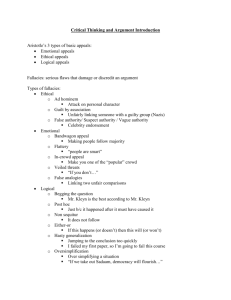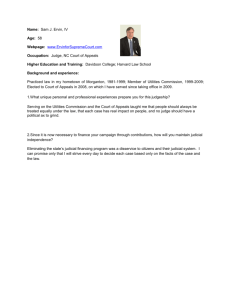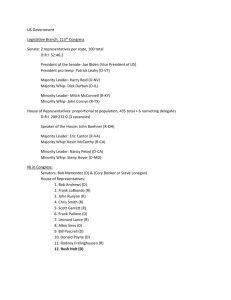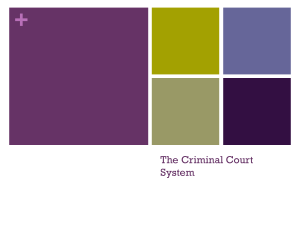File
advertisement
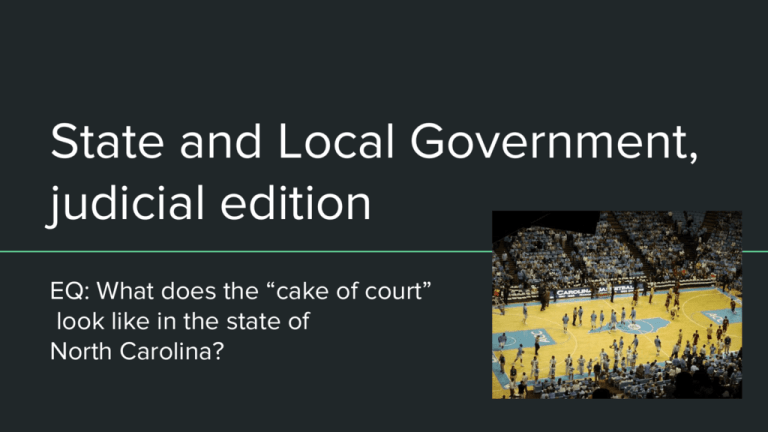
State and Local Government, judicial edition EQ: What does the “cake of court” look like in the state of North Carolina? _____L: warm-up 1. How many layers are in the U.S. “cake” of court? 2. What are the layers? 3. What term in civics is defined as a government in which power is divided between the federal, state and local levels? The BIG idea...it’s a piece of cake! :) District Courts -civil cases (minor) -misdemeanors/infractions Trial Courts, or District Courts, can be divided into four categories, civil, criminal, juvenile and magistrate. Like the Superior Court, District Court sits in the county seat of each county. It may also sit in certain other cities and towns, specifically authorized by the General Assembly. -juvenile cases -judges elected (4 year terms) Civil cases such as divorce, custody, child support and cases involving less than $25,000 are heard in District Court, along with criminal cases involving misdemeanors and infractions. The trial of a criminal case in District Court is always without a jury. The District Court also hears juvenile cases involving children under the age of 16 who are delinquent and children under the age of 18 who are undisciplined, dependent, neglected or abused. Magistrates (see magistrate section) accept guilty pleas for minor misdemeanors, accept guilty pleas for traffic violations and accept waivers of trial for worthless-check cases among other things. In civil cases, the magistrate is authorized to try small claims involving up to $10,000 including landlord eviction cases. Superior Courts -civil cases ($10,000+) -felonies All felony criminal cases, civil cases involving more than $10,000 and misdemeanor and infraction appeals from District Court are tried in Superior Court. A jury of 12 hears the criminal cases. In the civil cases, juries are often waived. -misdemeanors/infraction appeals -jury of 12 in criminal cases -elected judges (8 year terms) Superior Court is divided into eight divisions and 50 districts across the state. Every six months, Superior Court judges rotate among the districts within their division. The rotation system helps avoid favoritism that might result from having a permanent judge in one district. Court of Appeals -15 judges (8 year terms) bios + panels of 3 judges -See appeals from district and superior courts The Court of Appeals is North Carolina's intermediate appellate court. Fifteen judges hear cases in panels of three. The Court of Appeals reviews the proceedings that occurred in the trial courts for errors of law or legal procedure; it decides only questions of law - not questions of fact. All cases appealed from the Superior and District courts in civil and criminal cases, except capital murder cases in which the Superior Court pronounces a judgment imposing the death penalty, are heard by the Court of Appeals. In addition, direct appeals from certain of the state’s administrative agencies are heard by the Court of Appeals. In the 2011 calendar year, 1,615 appeals, 953 petitions, and 3,833 motions were filed in the Court of Appeals; during the same period the Court disposed of 1,835 appeals, and 4,301 petitions and motions. Supreme Court -1 chief justice, 6 associate justices (bios) -No jury -Elected (8 year terms) The Supreme Court of North Carolina is the state's highest court, and there is no further appeal in the state from their decisions. This court has a chief justice and six associate justices who sit together as a panel in Raleigh. The Supreme Court has no jury, and it makes no determination of fact; rather, it considers error in legal procedures or in judicial interpretation of the law. A few cases dealing with the NC Courts... --Bayard v. Singleton (1787) --State v. Mann (1830) --Swann v. Mecklenburg Co. (1971)* --Leandro v. State (1997) --Hart v. State (2015) *SCOTUS Paper Slideshow Court Case Assignment --In groups of 3-4, you will create a paper slideshow for your assigned court case. Your slideshow should consist of the following: a. background of the case b. the court’s decision c. impact of the case Use the information provided and do some research on your own! You will need a minimum of 5 slides in your presentation. You must also have a written script of what will be said in the show. The slides should have color and be aesthetically pleasing. The slideshow should be at least 1.5 minutes in length. You will upload your finished product to YouTube or e-mailed to the teacher to share with the class. Court cases in N.C. --10 minutes to work on slides. --Record your paper slideshow on your phones. Publish to YouTube. --We will present them to the class. :) Bayard v. Singleton (1787) background decision impact State v. Mann (1830) background decision impact Swann v. Mecklenburg Co. (1971)* background decision impact Leandro v. State (1997) background decision impact Hart v. State (2015) background decision impact

